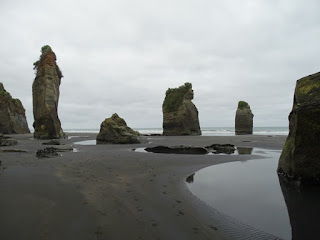Tongaporutu is a small place 15km south of Mokau, about 68km north of New Plymouth. It's situated at the mouth of the Tongaporutu River, just off State Highway 3. As you travel along the highway, this is the view if you look to the east towards the sea as you cross the bridge.
There's a great free camping spot where you can stay for three days if you're fully self-contained. We're near the end; there's more parking space on the left side of the photo, closer to the river.
At low tide, you can walk along the black sand towards the river mouth, then along the beach towards "The Three Sisters". It's an easy walk but can be slippery in places, especially alongside the river. I wore sneakers, but when you get to the beach, there are a lot of places where water flows from the land down to the sea and to get past those, you might need to get your feet wet.
The cliffs along here consist of grey papa and sandstone. The action of the ocean is consistently shaping and eating away at the coastline. I read that it's believed to be eroding at the rate of two metres annually.
One of the first rock formations we came to had an interesting carving of a face on it.
Looking back at this huge rock, you can see how the sea and weather have created caves and tunnels.
Looking past the rock, the landform you can see in the background is actually on the other side of the river mouth. The effect of the sea is obvious here as well with caves clearly visible.
Eventually, we arrived at The Three Sisters, or what is now "The Two Sisters" since the sea claimed one of them. In the distance to the left is what's left of Elephant Rock — you can make out the two legs and back of the elephant, but it lost it's trunk to erosion in 2016.
We've travelled past Tongaporutu for years, and this is the first time we've stopped to have a look. It's so easy to be 'too busy' and miss out on experiencing this beautiful area. Twenty years ago there were apparently
four sisters! So if you want to see these, take the time to stop before the sea claims them all. Having said that, in the photo above, you can see another pillar to the left, so who knows what the sea will carve out of the landscape over the next twenty years.
This, I believe, is one of the original Three Sisters with the top shaped to look like a face. She currently provides a home for nesting white-fronted terns. (I think that's what they are!) They're the white dots halfway up.
A closer view ... Mumma tern and her chick are safe from humans with their nest way up here.
Here's a closer look at the coastline on the other side of the river mouth. During high tide, most of these caves would be underwater.
On our way back, we stopped to chat with Gavin, our motorhome neighbour. You never know who you're going to come across while travelling ... we knew Gavin and Vicki when we lived in Stratford about 20 years ago. Although no fish were caught today, I understand kahawai have been in the past.
Walking back along the side of the river. This walk is not possible at high tide, so you need to time your visit to make sure you can access the beach and have long enough to see what you want to without getting caught by the incoming tide. It's only about a 15-minute walk to the rock formations, and the coastline all along the way is well worth seeing.
On the day we left, I took this photo as we drove over the bridge. You can see where the campers park on the right side of the photo.
If you cannot see "Post a Comment"
below and want to talk to me, click here (and
scroll down to the bottom of the post).


































